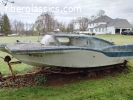|
Welcome,
Guest
|
TOPIC: Stringers???
Stringers??? 13 years 3 months ago #60434
|
|
Please Log in or Create an account to join the conversation. |
Re:Stringers??? 13 years 3 months ago #60797
|
Please Log in or Create an account to join the conversation. |
Re:Stringers??? 13 years 1 month ago #63307
|
Please Log in or Create an account to join the conversation. |
Re:Stringers??? 13 years 1 month ago #63309
|
Please Log in or Create an account to join the conversation.
3 cd g3's
1 seafair sedan |
Time to create page: 0.048 seconds














